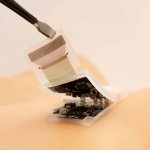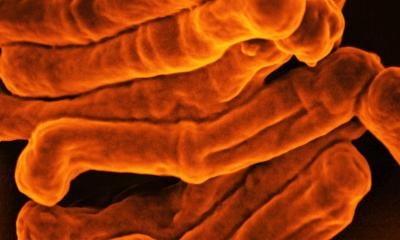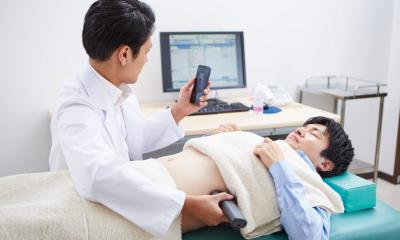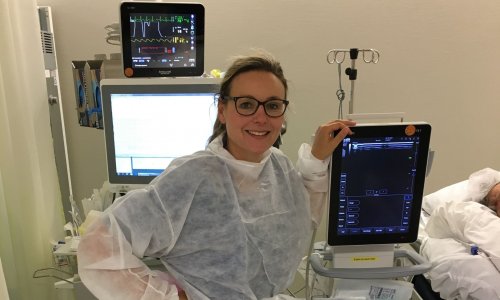Article • Portable imaging
Going mobile: advances in point-of-care ultrasound
Ultrasound technology now plays a vital role in clinical diagnosis and management. Significant advances in point-of-care ultrasound (POCUS) have made it a versatile tool for assessment, diagnosis, and follow-up across various fields. New developments continue to expand its applications, improving patient care and outcomes.
Report: Bernard Banga
Image source: Adobe Stock/samunella
Critical care ultrasound: A tool for risk reduction
‘POCUS can assist in the evaluation of undifferentiated sepsis. It can also contribute to the differential diagnosis of other types of shock, thus facilitating the decision-making process,’ said Effie Polyzogopoulou, Assistant Professor of Emergency Medicine at the National and Kapodistrian University of Athens, Greece, and Chair of the European Society for Emergency Medicine (EUSEM) Ultrasound Section.
In the latest Global Burden Diseases report, sepsis-associated morbidity was estimated at 48.9 million global cases while the mortality rate was reported at 11 million deaths, or one in five deaths worldwide.1 Considering that sepsis-related morbidity and mortality rates remain high, detection and exploitation of enhanced bedside techniques that would facilitate early diagnosis and effective management of sepsis become imperative. In this context, POCUS has high specificity, more than 91% for the four subtypes of non-traumatic hypotensive shock and approximatively 80% for mixed types. ‘Hence the importance of the roll-out and deployment of POCUS in the emergency department with focused cardiac ultrasound, lung ultrasound, abdominal, pelvic and urinary tract ultrasound, as well as vascular and transcervical ultrasound,’ said Polyzogopoulou.
In medical settings, ultrasound has many benefits – including, but not limited to its portability, non-invasiveness, low cost, absence of radiation, real-time imaging capability and bedside assessment. For these reasons, POCUS has rapidly emerged as an excellent multimodal tool and has been gradually incorporated as an adjunct to physical examination in order to facilitate evaluation, diagnosis and management.
Integration of point-of-care diagnostics into a wider variety of fields
Many other clinical fields benefit from POCUS technological developments. Several main technological advancements have contributed to the development of POCUS enhancing bedside patient care:
- First, rapid technological advances in electronics and piezoelectric materials provided further improvements from bistable to greyscale images and from still images to real-time moving images.
- Second, the exponential increases in processing power have allowed for faster and more powerful systems incorporating digital beamforming, increased enhancement of the signal, and new ways of interpreting and displaying data, such as 3D power doppler imaging.
- Third, handheld ultrasound systems allow for portable imaging. These technological advancements make ultrasound more ubiquitous, particularly at the point of care. POCUS devices are easier to use, take up very little space, and can be carried in a pocket. Many handheld ultrasound devices also provide comparable image quality to most mid-range traditional ultrasound systems.
- Fourth, innovations in miniaturization and wireless connectivity continue to improve the portability and ease of use of ultrasound devices.
Checklist: 153 items to assess POCUS proficiency
There are still challenges for development of ultrasound devices and applications to move forward into a subspecialty of clinical disciplines
Chengzhong Peng
The recent development of a multisystem point-of-care ultrasound skills assessment checklist published in the Ultrasound Journal2 has been a significant advancement. This consensus-based, multispecialty POCUS checklist evaluates skills in image acquisition and anatomy identification for various systems and disciplines: basic cardiac systems, abdominal, and vascular ultrasound, as well as peripheral intravenous line insertion. ‘This 153-item checklist serves as a standardized tool to assess and evaluate the proficiency of clinicians in performing POCUS examinations across different specialties,’ said Nilam J. Soni, Professor of Medicine and Academic Hospitalist at the University of Texas School of Medicine in San Antonio and the South Texas Veterans Health Care System.
Although portable ultrasound equipment has achieved technical integration (i.e., multiple imaging functions in a single unit) and miniaturization such as handheld ultrasound devices, ‘there are still challenges for development of US devices and applications to move forward into a subspecialty of clinical disciplines,’ said Chengzhong Peng, MD, Chief Physician at the Shanghai Tenth People’s Hospital of Tongji University and the Shanghai Engineering Research Center of Ultrasound Diagnosis and Treatment. A specially designed ultrasound machine with new concepts is needed in developing specialty-oriented instruments.
Recommended article

Wearable monitoring device
Wireless ultrasound patch monitors vital signs in deep tissues
A team of researchers and scientists from the University of California, San Diego (UCSD) have developed a stick-on ultrasound patch, the first fully integrated wearable system for evaluating cardiovascular function while people walk, run, or even ride a bicycle. This Ultrasonic system-on-patch (USoP) is the result of several years of research conducted by nanoengineering department engineers.
Tele-remote and 5G networks
The world of point-of-care ultrasound is rapidly evolving, with the integration of cutting-edge technologies such as artificial intelligence (AI), cloud computing, 5G networks, robots, and tele-remote technology, Dr Peng points out. This integration is transforming the specialized POCUS system into an intelligent terminal platform, with the potential to transform healthcare as we know it.
Tele-remote ultrasound allows for remote real-time diagnosis and interventional procedures through high-precision synchronization via video, audio, text, and other multichannel communications. Using a remote robotic ultrasound system, expert doctors can use their own skill for remote ultrasonic scans and providing medical diagnosis based on real-time ultrasound imaging generated by robotic scanning.
These advances are further driven by the advent of 5G technologies, which play a crucial role in enabling long-distance, real-time, high-bandwidth, high-resolution, and low-latency requirements for remote ultrasound consultation and robotic operations. This has proven invaluable during the Covid-19 pandemic, allowing remote assessment of patients' lung lesions and guidance during interventional procedures, thus conserving expert resources and minimizing cross-infection risks. However, remote ultrasound is not conducted for large-scale clinical applications, and it can only be used as a basic screening tool for special situations at present due to the lack of unified standards for image acquisition, quality control, data transmission, and security.
AI integration in ultrasound imaging: advances and challenges
With the recent integration of artificial intelligence into diagnostic ultrasound imaging, POCUS aims to harness the power of this technology for rapid image processing, standardization, and continuous workflow. The integration of AI in ultrasound equipment has led to built-in intelligent evaluation features, optimization of image quality, and smart screening, acquisition, analysis and data processing. This has enabled ultrasound operators to bypass complicated image optimization and measurement procedures, focusing instead on clinical diagnosis and treatment.
Ultrasound with AI technology has been applied in clinical practice, such as minimally invasive intervention, thyroid, breast, musculoskeletal, paediatrics, and cardiac examinations, improving the accuracy of clinical ultrasound diagnosis. For example, a study published in Ultrasonics showed that the coincidence rate by AI-based ultrasound systems in the interpretation of benign and malignant thyroid nodules increased from 64% to 84%.3
However, there are still many challenges in AI ultrasound applications. The huge quantity of data generated in the short term puts higher requirements on algorithms and computing power. Computing power limitations need to be solved to ensure that the AI model can be effectively used on tablets and mobile phone platforms.
A market worth $5.9 billion by 2030
Last, but not least, cloud computing is a new type of computing platform that has the advantages of low cost, high reusability, high performance, and easy expansion. Through the Internet, it accelerates the integration of a large number of algorithmic formulas and storage resources, and then distributes them to specific users accordingly. Recently, with the application of mobile terminal devices such as mobile phones, tablets and computers, cloud computing technology has brought about new changes for ultrasound diagnosis. The ultrasound system on the patient side is responsible for collecting image data, while the mobile device on the doctor side displays the image data. This data can be transmitted in real time between the two locations, and remote consultations can be provided via 5G technology and cloud platforms.
These technological developments have paved the way for next-generation POCUS devices that are highly portable, user-friendly, and accessible. Notably, handheld ultrasound systems are experiencing rapid growth in the market. According to Strategic Market Research, the global Point-of-Care Ultrasound market valued at $3.24 billion in 2022 is projected to grow at a robust compound annual growth rate of 5.7% by 2030, reaching $5.9 billion. Among the top ten medical technology leaders in specialty-oriented POCUS are American companies GE Healthcare, EU-based Koninklijke Philips, Siemens Healthineers, and Esaote, along with Japanese companies Canon Medical Systems, Fukuda Denshi and Fujifilm, South Korea-based Samsung Healthcare, and China-based Shenzhen Mindray Bio-Medical Electronics. As this technology continues to evolve, it holds the potential to transform healthcare delivery and enhance patient care across the globe.
References:
- Rudd et al.: Global, regional, and national sepsis incidence and mortality, 1990–2017: analysis for the Global Burden of Disease Study; Lancet 2020
- Soni et al.: Development of a multisystem point of care ultrasound skills assessment checklist; Ultrasound Journal 2022
- Ma et al.: A pre-trained convolutional neural network based method for thyroid nodule diagnosis; Ultrasonics 2017
12.11.2023











